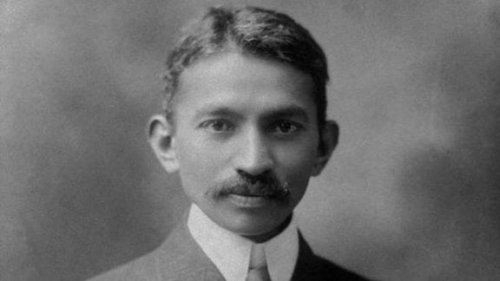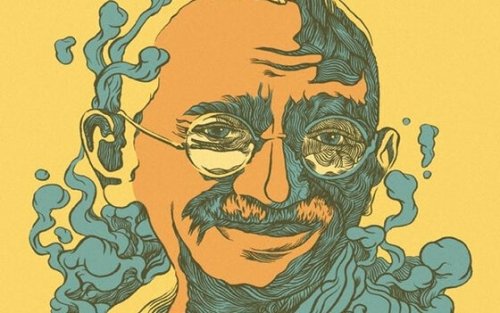Mahatma Gandhi: A Peaceful Revolution


Written and verified by the psychologist Valeria Sabater
The legacy of Mohandas Karamchand Gandhi, better known as Mahatma Gandhi, will always live on. He was a man who wanted to start a peaceful revolution to defend the civil rights of his country. He became a political and spiritual leader whose nonviolent disobedience inspired the entire world.
October 2 is International Day of Non-Violence. On this day, people reflect on what the leader of the Indian independence movement accomplished in the middle of the 20th century.
During his nearly three decades of peaceful activism, he didn’t just yearn to free his people from the British Raj. He defended social justice and aspired to transform economic structures. Thus, he taught society that mutual understanding could be possible between different religions and peoples.
From naive lawyer to brilliant activist

Mohandas K. Gandhi was born in Porbandar in 1869. His father was Prime Minister of Gujarat, and his mother belonged to the branch of Hinduism. In addition, she was a woman distinguished for her tolerance and for the defense of peaceful coexistence between all religions.
He grew up in a privileged environment in every way. He was financially well-off. His mentors instilled spirituality in him early on. He was vegetarian, fasted often, and was committed to his culture.
However, his family selected him out of his two older brothers to improve his academic training. For this reason, they sent him to London in 1888 to study law. This stage in his life helped build his identity, social activism, and philosophical conviction.
In England, he was in close contact with the circle of theosophists. They initiated him in the Bhagavad Gita, the sacred book of the Hindus, which inspired him decisively in his religious ideals and principles.
After he got his degree, the inexperienced lawyer went to South Africa, a divided and unstable country made up of multiple colonies governed by the British and the Dutch. In this context, a decisive stage in his life began. Then, the young lawyer suddenly became a strong defender of equality and freedom.
Actually, in South Africa, the four characteristics that defined Mahatma Gandhi arose. He was a:
- Defender of freedom.
- Social reformer.
- Spokesman for the tolerance of all religions.
- Spiritual leader.

The fight for the independence of India
When Gandhi returned to his country in 1915, things had flared up in India. Also, they were about to pass a law that would forbid suffrage to Hindus. At this time, he began to apply the same social activism that he started in South Africa. Thus, he called his people to resist and exercise Satyagraha (the creed of non-violence).
The world, in turn, brought the echoes of World War I and he began to lay the foundations for peaceful independence in India. To do so, he resorted to a tactical and intellectual approach as novel as it was inspiring for multiple generations. Mahatma Gandhi created a farm in the city of Ahmedabad to gather his disciples.
As you can see, he became a spiritual leader who inspired multiple communities. Little by little, the peaceful settlements multiplied, which in turn sparked the engines of a great revolution.
An effective strategy was to stop cotton production, a key piece for the British textile industry. Then, he did the same with the British salt monopoly. Civil disobedience campaigns took thousands of lives and cost them several years in prison. However, they achieved their goal: the independence of India as a British colony happened on August 18, 1947.
Just a few months later, on January 30, 1948, Nathuram V. Godse, a Hindu extremist, assassinated Gandhi in a crowd. He was 78 years old.
Mahatma Gandhi’s guidelines on Satyagraha
Satyagraha was a word Gandhi invented to represent his fight, based on the firm conviction that he shouldn’t resort to violence.
Thus, this humble and firmly obstinate man defended social rights (to the point of being nominated five times for the Nobel Peace Prize). He insisted that life is indivisible and that as such, it’s inconceivable that one person could cause any harm to another. Therefore, any active fight for the good and defense of those who suffer must be based on satyagraha, a dimension that included the following principles:
- Be truthful.
- Don’t steal.
- Respect all religions.
- Believe in truth and nonviolence and have faith in the intrinsic goodness of human beings.
- A resistance civilian will neither be angry nor hateful.
- Said civilian will withstand the assaults of their opponent, without backing down nor feeling fear.
- They’ll allow themselves to be arrested.
- The resistant will refuse to give up their properties.
- Also, they won’t retaliate or be vengeful.
- They won’t resort to insults.
- A tough civilian won’t salute the UK flag but they won’t insult it either.
- If there’s a fight, the resistance will protect the officers from attacks and insults.

Conclusion on Mahatma Gandhi
Gandhi produced an undeniable change in 20th-century thinking. He left an inspiring trail, just like Martin Luther King and Mandela. These types of legacies are, undoubtedly, a challenge for this era. Thus, collecting witness accounts and learning from these figures is something everyone should reflect on to improve the course of civilization.
“The weak can never forgive. Forgiveness is the attribute of the strong.”
-M. Gandhi-
The legacy of Mohandas Karamchand Gandhi, better known as Mahatma Gandhi, will always live on. He was a man who wanted to start a peaceful revolution to defend the civil rights of his country. He became a political and spiritual leader whose nonviolent disobedience inspired the entire world.
October 2 is International Day of Non-Violence. On this day, people reflect on what the leader of the Indian independence movement accomplished in the middle of the 20th century.
During his nearly three decades of peaceful activism, he didn’t just yearn to free his people from the British Raj. He defended social justice and aspired to transform economic structures. Thus, he taught society that mutual understanding could be possible between different religions and peoples.
From naive lawyer to brilliant activist

Mohandas K. Gandhi was born in Porbandar in 1869. His father was Prime Minister of Gujarat, and his mother belonged to the branch of Hinduism. In addition, she was a woman distinguished for her tolerance and for the defense of peaceful coexistence between all religions.
He grew up in a privileged environment in every way. He was financially well-off. His mentors instilled spirituality in him early on. He was vegetarian, fasted often, and was committed to his culture.
However, his family selected him out of his two older brothers to improve his academic training. For this reason, they sent him to London in 1888 to study law. This stage in his life helped build his identity, social activism, and philosophical conviction.
In England, he was in close contact with the circle of theosophists. They initiated him in the Bhagavad Gita, the sacred book of the Hindus, which inspired him decisively in his religious ideals and principles.
After he got his degree, the inexperienced lawyer went to South Africa, a divided and unstable country made up of multiple colonies governed by the British and the Dutch. In this context, a decisive stage in his life began. Then, the young lawyer suddenly became a strong defender of equality and freedom.
Actually, in South Africa, the four characteristics that defined Mahatma Gandhi arose. He was a:
- Defender of freedom.
- Social reformer.
- Spokesman for the tolerance of all religions.
- Spiritual leader.

The fight for the independence of India
When Gandhi returned to his country in 1915, things had flared up in India. Also, they were about to pass a law that would forbid suffrage to Hindus. At this time, he began to apply the same social activism that he started in South Africa. Thus, he called his people to resist and exercise Satyagraha (the creed of non-violence).
The world, in turn, brought the echoes of World War I and he began to lay the foundations for peaceful independence in India. To do so, he resorted to a tactical and intellectual approach as novel as it was inspiring for multiple generations. Mahatma Gandhi created a farm in the city of Ahmedabad to gather his disciples.
As you can see, he became a spiritual leader who inspired multiple communities. Little by little, the peaceful settlements multiplied, which in turn sparked the engines of a great revolution.
An effective strategy was to stop cotton production, a key piece for the British textile industry. Then, he did the same with the British salt monopoly. Civil disobedience campaigns took thousands of lives and cost them several years in prison. However, they achieved their goal: the independence of India as a British colony happened on August 18, 1947.
Just a few months later, on January 30, 1948, Nathuram V. Godse, a Hindu extremist, assassinated Gandhi in a crowd. He was 78 years old.
Mahatma Gandhi’s guidelines on Satyagraha
Satyagraha was a word Gandhi invented to represent his fight, based on the firm conviction that he shouldn’t resort to violence.
Thus, this humble and firmly obstinate man defended social rights (to the point of being nominated five times for the Nobel Peace Prize). He insisted that life is indivisible and that as such, it’s inconceivable that one person could cause any harm to another. Therefore, any active fight for the good and defense of those who suffer must be based on satyagraha, a dimension that included the following principles:
- Be truthful.
- Don’t steal.
- Respect all religions.
- Believe in truth and nonviolence and have faith in the intrinsic goodness of human beings.
- A resistance civilian will neither be angry nor hateful.
- Said civilian will withstand the assaults of their opponent, without backing down nor feeling fear.
- They’ll allow themselves to be arrested.
- The resistant will refuse to give up their properties.
- Also, they won’t retaliate or be vengeful.
- They won’t resort to insults.
- A tough civilian won’t salute the UK flag but they won’t insult it either.
- If there’s a fight, the resistance will protect the officers from attacks and insults.

Conclusion on Mahatma Gandhi
Gandhi produced an undeniable change in 20th-century thinking. He left an inspiring trail, just like Martin Luther King and Mandela. These types of legacies are, undoubtedly, a challenge for this era. Thus, collecting witness accounts and learning from these figures is something everyone should reflect on to improve the course of civilization.
“The weak can never forgive. Forgiveness is the attribute of the strong.”
-M. Gandhi-
All cited sources were thoroughly reviewed by our team to ensure their quality, reliability, currency, and validity. The bibliography of this article was considered reliable and of academic or scientific accuracy.
- Fischer, L. (2000). Gandhi: su vida y su mensaje a la humanidad. Ediciones B-Mexico.
- Gandhi, M., & Lacambra, L. L. (1981). Todos los hombres son hermanos. Sociedad de educación Atenas.
- Vargas, V. P. Una filosofía concreta del derecho humano para la paz: Mahatma Gandhi. Revista de Ciencias Jurídicas, (41).
- Wolpert, Stanley (2005) Gandhi, la biografía más profunda del alma grande de la India. Ariel
This text is provided for informational purposes only and does not replace consultation with a professional. If in doubt, consult your specialist.







